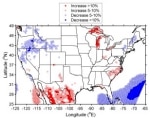As climate change dramatically changes weather patterns in some areas, will it negatively affect the wind energy industry? Will favourable conditions decline and installations of thousands of wind turbines suffer a massive reduction in output as a result? A recent study sought to take a peek into the future of wind power’s long term viability in the USA.
Researchers from Indiana University Bloomington crunched the numbers produced by several regional climate models to try and get an idea of the future wind patterns in America’s lower 48 states.
The climate models used were the Canadian Regional Climate Model, Regional Climate Model 3 and the Hadley Centre Model. The study was performed by Sara Pryor and Rebecca Barthelmie, both professors of atmospheric science. Results show the difference in energy density (power in the wind) between 2041-2062 and 1979-2000.
The good news is areas where decreases in wind density are predicted are quite limited and many of the areas are unlikely to see establishment of wind farms. Areas expected to see continuing high wind density include above the Great Lakes, eastern New Mexico, southwestern Ohio, southern Texas and large areas of several states in Mexico.
Professor Pryor said while there was noticeable variability in predicted wind densities, the variability was very similar to that observed in current wind patterns
With the wind power industry in the USA aiming for wind energy to provide 20 percent of America’s total electricity production by 2030, the results of the study, the first assessment of its type ever carried out, will be welcomed.
As climate change models are continuously refined, Professor Pryor says she intends to continue the assessments as new models become available.
According to the American Wind Energy Association, the industry installed 1,100 MW of new capacity in the first quarter of 2011 and began the second quarter with an additional 5,600 MW under construction.
Source/image source












































